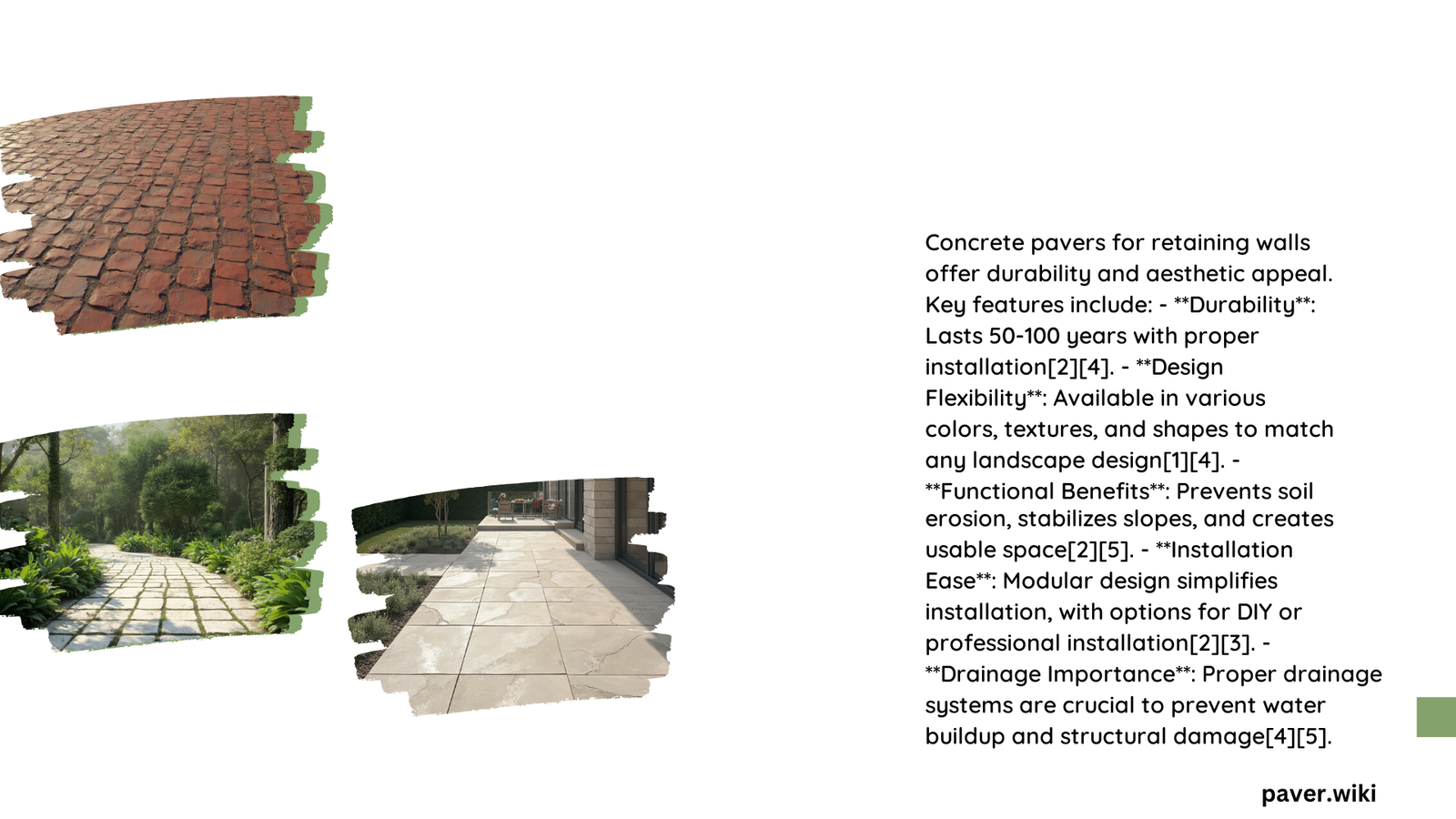Concrete pavers retaining walls are robust structures designed to hold back soil and create level areas in landscapes with varying elevations. These walls combine the strength of concrete with the versatility of interlocking pavers, offering both functional and aesthetic benefits. They are widely used in residential and commercial settings for their durability, ease of installation, and ability to withstand significant lateral earth pressures.
What Are the Key Components of Concrete Pavers Retaining Walls?
Concrete pavers retaining walls consist of several essential components:
- Foundation: A compacted base of gravel or crushed stone
- Concrete paver blocks: Interlocking units that form the wall structure
- Backfill: Material placed behind the wall for drainage and support
- Geogrid: A reinforcement layer used in taller walls
- Drainage system: Prevents water buildup behind the wall
How Are Concrete Pavers Retaining Walls Constructed?

The construction process for concrete pavers retaining walls involves several steps:
- Site preparation and excavation
- Base installation and compaction
- Laying the first course of pavers
- Backfilling and compaction
- Installing subsequent courses with proper offset
- Incorporating drainage systems
- Adding geogrid reinforcement for taller walls
- Finishing with cap stones or top course
What Are the Dimensional Specifications for Concrete Pavers Retaining Walls?
Concrete pavers for retaining walls come in various sizes, but standard specifications include:
- Standard Block Units:
- Dimensions: 24″ Height x 48″ Width x 24 – 26″ Depth
- Face Area: 8 sq ft
-
Weight: 1370 – 1466 lbs
-
Half-High Blocks:
-
Dimensions: 12″ Height x 48″ Width x 24″ Depth
-
Load-Bearing Capacity: Minimum 110 lbs total weight per square foot of wall face area
What Is the Optimal Height and Thickness for Concrete Pavers Retaining Walls?
The optimal height and thickness depend on various factors:
- Base material depth:
- 4 inches for walls under 4 feet
- 6 inches for walls over 4 feet
- Standard block thickness: 24-26 inches
- Maximum height without reinforcement: Typically 3-4 feet
- Taller walls require geogrid reinforcement and engineering design
How to Ensure Proper Drainage in Concrete Pavers Retaining Walls?
Proper drainage is crucial for the longevity of concrete pavers retaining walls:
- Use free-draining granular material (0.25 in. to 1.5 in.) behind the wall
- Install a perforated drain pipe at the base of the wall
- Ensure less than 10% of drainage material passes through a #200 sieve
- Compact drainage material in layers using a plate compactor
- Slope the ground away from the wall to direct surface water
What Are the Aesthetic Options for Concrete Pavers Retaining Walls?
Concrete pavers retaining walls offer various aesthetic options:
- Textured exterior faces for visual appeal
- Wide range of colors to match or complement landscapes
- Different block shapes for unique patterns
- Caps and accent pieces for a finished look
- Ability to create curves and corners for design flexibility
How to Maintain Structural Integrity in Concrete Pavers Retaining Walls?
To maintain structural integrity:
- Ensure proper base preparation and compaction
- Use blocks with adequate freeze-thaw protection
- Achieve a minimum 28-day compressive strength of 3000 psi
- Offset each course by at least 3 inches from the course below
- Incorporate geogrid reinforcement for taller walls
- Regular inspection and maintenance of drainage systems
What Are the Cost Factors for Concrete Pavers Retaining Walls?
Several factors influence the cost of concrete pavers retaining walls:
- Material costs:
- Block prices vary by size, style, and manufacturer
-
Additional materials like gravel, geogrid, and drainage pipes
-
Labor rates:
- Complexity of the project
- Wall height and length
-
Site accessibility
-
Site preparation:
- Excavation requirements
-
Soil conditions and necessary amendments
-
Design complexity:
- Curves, corners, and steps increase costs
-
Engineered designs for taller walls
-
Finishing touches:
- Cap stones
- Lighting integration
- Landscaping around the wall
What Are the Potential Challenges in Installing Concrete Pavers Retaining Walls?
Installing concrete pavers retaining walls can present several challenges:
- Soil conditions:
- Unstable or expansive soils may require additional preparation
-
Poor drainage can lead to wall failure
-
Compaction issues:
- Achieving 95% Standard Proctor density for base and backfill
-
Proper equipment and technique required
-
Weather conditions:
- Freeze-thaw cycles can affect wall stability
-
Extreme temperatures may impact installation process
-
Height limitations:
- Local building codes may restrict wall heights
-
Taller walls require engineering expertise
-
Underground utilities:
- Locating and working around existing utilities
-
Potential for project delays or redesigns
-
Water management:
- Ensuring proper drainage to prevent hydrostatic pressure
- Dealing with groundwater or surface runoff
By addressing these challenges and following proper installation techniques, concrete pavers retaining walls can provide long-lasting, attractive solutions for landscape grade changes and soil retention.
References:
1. https://magnumstone.com/engineering/block-specifications/
2. https://www.arcat.com/sdspecs/htm04/32_32_19abc.htm
3. https://allanblock.com/specifications/allanblock-specs.aspx
